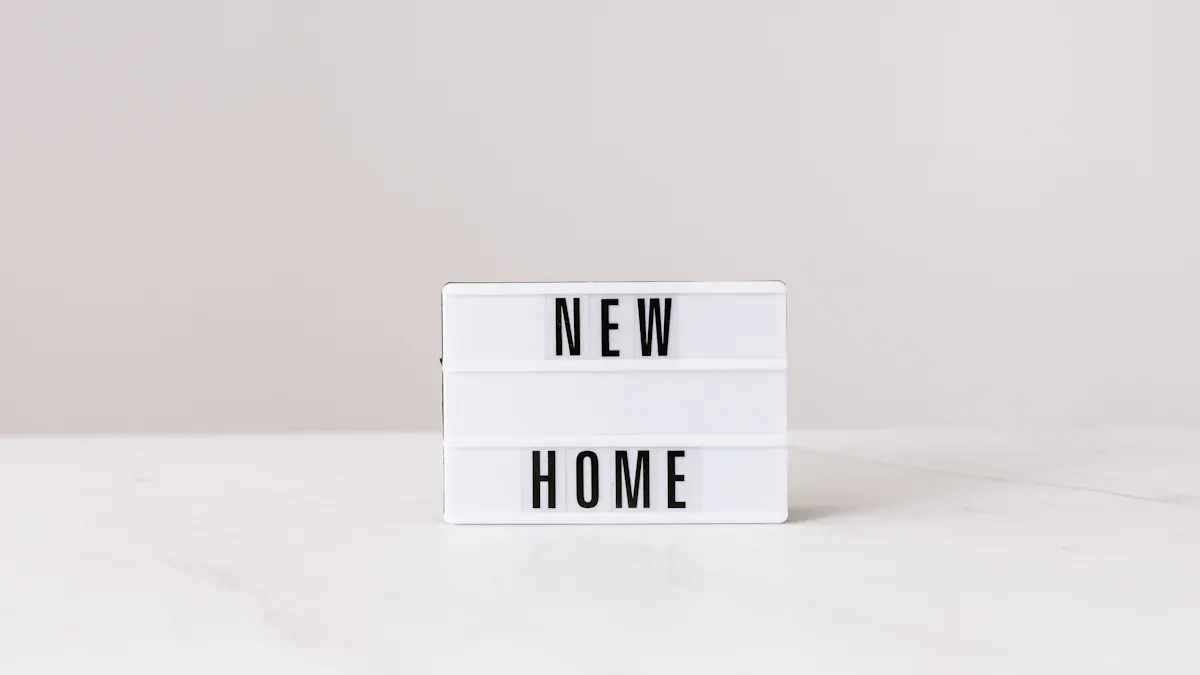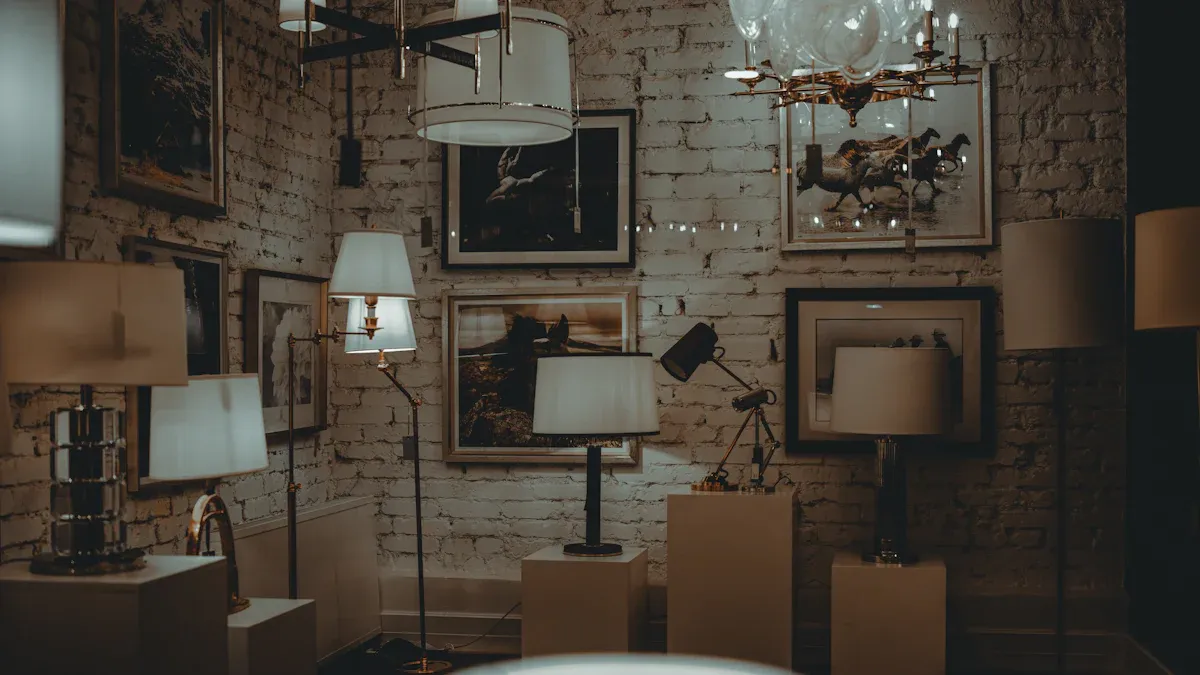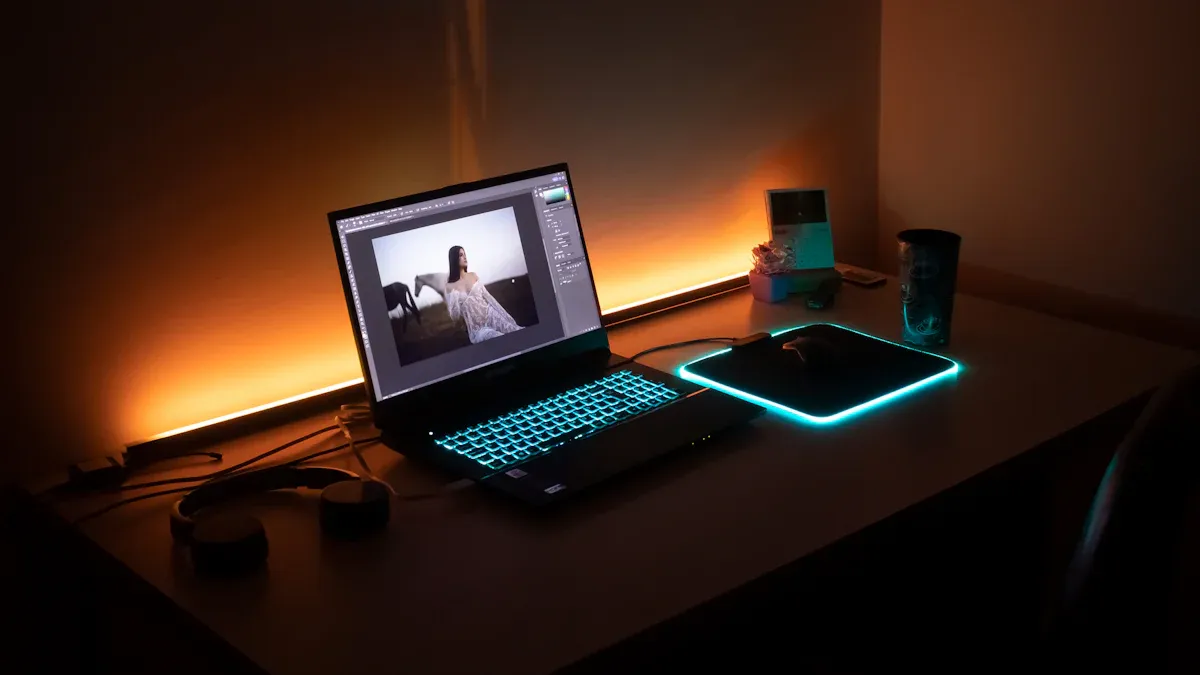Lightbox Lighting: Types, Installation, and Optimization Techniques

Lightbox lighting uses LED or fluorescent lights in a frame. These lights help show off graphics or surfaces. You can see lightbox displays in many places. Stores use them to make products stand out. They also make 62% of shoppers buy things without planning. Businesses use lightboxes for logos and backlit posters. This helps people remember their brand. At home, you can make your own art with a lightbox. You can also use it to set a nice mood. Picking the right type and installing it well gives you the best results.
Application Type | Description | Statistic |
|---|---|---|
Branding and Advertising | Bright signs, logo displays, and backlit posters | Helps people remember the brand |
Retail and Visual Merchandising | Eye-catching displays make people buy things | 62% of shoppers buy because of displays |
Home and Interior Design | Custom LED art and mood lighting | More people use them in home décor |
Key Takeaways
Lightbox lighting helps people see better. It also helps people notice brands. This makes it a strong way for businesses to get customers.
Picking the best lightbox type depends on what you need. You can choose back-lit, edge-lit, tabletop, wall-mounted, or freestanding. Your space matters when you decide.
Installing and taking care of lightboxes is important. This keeps them working well and looking nice for a long time.
Using good LEDs with the right brightness and color makes your lightbox look better.
Cleaning your lightbox often and fixing problems stops issues. This helps your lightbox work its best.
Lightbox Lighting Overview
What Is Lightbox Lighting
Lightbox lighting is used in places where bright displays are important. It has a frame, usually made of strong aluminum, that holds lights and graphics. Inside the frame, LED modules connect to a transformer. This setup keeps the lights safe and saves energy. The front of the lightbox is often made from opal acrylic. This material lets light pass through and keeps the display smooth. You can put graphics on by printing or using colored vinyl for special looks. Some lightboxes have a push-through face. This gives a 3D look and makes the edges glow.
Here is a quick look at the main parts of a lightbox:
Component/Feature | Description |
|---|---|
Lightbox Structure | Made from aluminum, often powder-coated for color and durability. |
Illumination Source | Uses LED modules with a transformer for safe, low-voltage operation. |
Face Material | Opal acrylic allows even light diffusion and an opaque appearance. |
Graphic Application | Graphics printed or applied on vinyl for custom designs. |
Alternative Design | Push-through face for 3D effects and glowing edges. |
Lightbox lighting is different from other display lights. Backlighting shines from behind things and is good for machines or checking quality. Lightbox systems spread light evenly across the whole display. This makes them great for stores, shows, and public places.
Why Lightbox Lighting Matters
You want your message to be noticed. Lightbox displays help make that happen. They make signs and graphics easy to see, even from far away or in dim light. Businesses use lightboxes to get more people to notice them and remember their brand. The bright, even light grabs attention and makes displays look modern.
Some key benefits of using a lightbox include:
Benefit | Description |
|---|---|
High Visibility | Your message stays clear day and night. |
Aesthetic Appeal | Lightboxes give a polished, modern look. |
Customizability | You can choose any graphic, color, or shape for your display. |
Energy Efficiency | LED technology keeps costs low and helps the environment. |
Durability | Strong materials mean your display lasts longer. |
Versatility | Use lightboxes in stores, offices, restaurants, or art shows. |
Attention-Grabbing | Bright displays pull in more customers and boost sales. |
Cost-Effectiveness | Lightboxes offer a smart, long-term way to advertise. |
Tip: Bright signs keep customers interested longer and can help you sell more. A lightbox can make your store or brand easier to remember.
You can use lightbox lighting to make a space feel welcoming, show off products, or share messages. The right lightbox can turn a simple sign into a strong tool for your business or home.
Types of Lightbox Lighting

Back-Lit Lightboxes
Back-lit lightboxes have LED panels behind the graphic. This makes the whole display bright and even. They are good for advertising in busy places. You can find them in airports, malls, and trade shows. These lightboxes help your message stand out in crowds or dark spots. Many companies use big backlit graphics to get noticed. For example, the BidWrangler 10x10 backlit display kit made their booth easy to see at events. Back-lit lightboxes need extra space behind the graphic for the lights. They also use more LEDs, so they can use more energy and need more care.
Edge-Lit Lightboxes
Edge-lit lightboxes have LEDs along the frame’s sides. The light spreads across a special panel to light the graphic. This gives a thin and modern look. Edge-lit systems use fewer LEDs than back-lit ones, so they save energy. You can use edge-lit advertising light box displays in offices, stores, or as front displays. Smart controls let you change brightness and set times for the lights. These features help you save energy and keep your display looking nice.
Tabletop Lightboxes
Tabletop lightboxes are small and easy to move. You can put them on counters, desks, or tables. They are good for showing products, tracing art, or menu boards. Many artists use tabletop lightboxes to trace their designs. Stores use them for small advertising light box displays near the checkout. You can move them quickly and set them up fast.
Wall-Mounted Lightboxes
A wall-mounted lightbox goes right on a wall. You see these in stores, restaurants, and offices. They are great for indoor lightboxes for branding or menus. You can also use a wall-mounted lightbox outside if it is weatherproof. These displays save floor space and keep your graphics at eye level. Double-sided lightboxes can also go on walls to show messages on both sides.
Freestanding Lightboxes
Freestanding lightboxes stand by themselves. You can put them anywhere in a room or event. They are good for trade shows, lobbies, and big stores. You can use double-sided lightboxes in this style to show graphics both ways. Freestanding lightboxes let you move and change your display when you want.
Pros and Cons of Each Type
Type | Pros | Cons |
|---|---|---|
Back-Lit Lightboxes | Brightest light, premium look, grabs attention fast | Higher energy use, more space needed, more upkeep |
Edge-Lit Lightboxes | Slim design, energy efficient, easy to install | Slightly less bright, may have edge shadows |
Tabletop Lightboxes | Portable, easy to set up, great for small displays | Limited size, less impact for large graphics |
Wall-Mounted Lightboxes | Saves space, eye-level display, good for indoor/outdoor | Needs wall space, fixed location |
Freestanding Lightboxes | Flexible placement, double-sided options, large graphics | Takes up floor space, may need extra support |
Note: When you pick a lightbox, think about where you will use it and how often you want to change the graphics. Double-sided lightboxes are best for open spaces. A wall-mounted lightbox is good for narrow hallways.
Lightbox Installation Basics
Essential Tools and Materials
You need the right tools to install a lightbox. Good parts help your display last longer and look nice. Here is a table to help you pick what you need:
Tool/Material | Description |
|---|---|
LED Lighting | Lights up your graphics evenly and brightly. |
Acrylic | Makes the box sturdy and keeps it lightweight. |
Steel Frame | Adds extra support for larger or heavier designs. |
High-Density Polypropylene (HDPP) | Flexible option, but you may need more support to stop bending. |
Acrylic is strong and light, so it works well. If you use HDPP, add support so the box does not bend. Always check that the lighting spreads out evenly. This step helps your graphics look their best and keeps the box safe.
Preparation Steps
Getting ready makes installing a lightbox easier and safer. Do these steps before you start:
Read the guides and manuals for your lightbox. Each one may need a different way to install.
Clean the area where you will work. Move anything that could get in your way.
Put out all your tools and materials. Keep them close so you do not have to stop.
These steps help you avoid mistakes and save time. They are important for a safe and easy installation.
Safety Precautions
It is very important to stay safe when you install a lightbox. Always use safety gear and follow these tips:
Use a voltage tester to make sure the wires are not live.
Wear insulated gloves and safety glasses to protect yourself.
Make sure your ladder is on flat ground and does not wobble.
If you work with big displays, wear flame-resistant clothes.
Staying safe keeps you from getting hurt by electricity or falling. Always follow the guides and manuals for more safety tips. These tips help you finish the job without getting hurt.
Installing LED Lightboxes
Step-by-Step LED Lightbox Installation
You can set up your new lightbox with a clear process. This step-by-step guide helps you avoid mistakes and get the best results. Follow these step-by-step instructions for a smooth led lightbox installation:
Unpack and Inspect
Open the box carefully. Check your led lightbox for any damage. Make sure all parts, cables, and accessories are present and in good shape.Prepare the Installation Area
Pick the best spot for your lightbox. Think about the wall type, how close it is to a power outlet, and the best viewing angle.Mark and Mount
Use a level and measuring tape to mark where you want the lightbox. Drill pilot holes at the marks. Mounting the lightbox securely is important for safety and stability.Connect the Power
Plug the led lightbox into a nearby outlet. Always follow safety rules for electrical work.Test and Adjust
Turn on the lightbox. Check if the lights work well. Adjust the settings if needed.Final Checks and Cleanup
Make sure the lightbox is straight and stable. Clean up the area and remove any packaging.Troubleshooting
If you see uneven lighting or the lightbox does not turn on, check the wiring and mounting. Ask a professional for help if you cannot fix the problem.Maintenance
Clean your lightbox often. This keeps it bright and looking new.
Tip: Always read the manufacturer's instructions before you start installing led lightboxes. This helps you avoid common mistakes and keeps your display working longer.
Mounting Wall-Mounted Lightboxes
Wall-mounted lightboxes need careful planning. You want your display to stay safe and look great. Here is how you can mount your lightbox on a wall:
Gather your tools. You need a drill, screwdriver, level, and wire connectors.
Turn off the power before you start any electrical work.
Find the wall studs. These give your lightbox strong support.
Mark the height for your lightbox. Most people place it 60 to 66 inches from the floor.
Drill screws into the wall studs to secure the mount.
Connect the wiring. Follow the manufacturer's instructions for led lightbox installation.
Attach the lightbox to the mount. Test to make sure it works.
Note: Always use the right anchors and screws for your wall type. This keeps your lightbox from falling.
Setting Up Tabletop and Freestanding Lightboxes
Tabletop and freestanding lightboxes are easy to move and set up. You can use them for art, menus, or product displays. Here are some steps to help you:
Place the lightbox on a flat, stable surface.
Plug the power cord into a safe outlet.
Use foam tape to secure led bars inside the frame if needed. This keeps the lights in place and stops rattling.
Route the wiring neatly. Hide wires to keep your display tidy.
Test the lightbox. Make sure the lighting is even and bright.
Callout: If you need to move your lightbox often, choose a lightweight model. This makes setup and transport easier.
Wiring and Electrical Tips
Good wiring keeps your led lightbox safe and bright. Follow these tips for the best results:
Check the voltage. Most led lightboxes use low voltage, less than 50 volts. Use a transformer to lower the line voltage.
Pick a transformer with enough power. Add up the total wattage of your leds and add 20% for safety.
Plan for voltage drop. Use thicker wire to keep the brightness even across the whole lightbox.
Wire fixtures in parallel. This gives each led the same voltage.
Use the right wire connectors. Secure connections stop flickering and failures.
Keep wires tidy. Avoid crossed connections to prevent shorts.
Use wire splitters for multiple connections. This stops you from overloading the controller.
Install led strip dimmers after the transformer. PWM dimmers help you control brightness.
Example | Solution | |
|---|---|---|
Using low-brightness led tape | A 5W/m led strip over a worktop is too dim | Use at least 10W/m strips |
Incorrect supply voltage | Connecting a 12V led strip to a 24V supply | Match the supply voltage to the led strip |
Poor ventilation | Mounting leds in a closed box | Use ventilation holes or better heat-dissipating strips |
Bad connections | Cheap connectors cause flickering | Use high-quality connectors |
Wrong dimmer | Standard dimmer causes flickering | Use led-compatible dimmers |
Ignoring color temperature | Cold white light in a bedroom | Use warm white light for comfort |
Bad positioning | Spotlights too far apart | Space leds evenly |
Outdoor use of indoor leds | Indoor strips get damaged outside | Use IP65 or higher rated strips outdoors |
Messy installation | Exposed wires look bad | Use profiles and hide wires |
Ignoring instructions | Skipping the manual | Always follow the manufacturer's instructions |
Alert: Never skip the manual. Manufacturer instructions help you avoid costly mistakes and keep your led lightbox working well.
Optimizing Lightbox Lighting

Choosing the Right LEDs
You want your lightbox to look bright and clear. Picking the right led is important for any display. There are three things to check: brightness, color temperature, and energy use. Brightness is measured in lumens. It shows how much light your led gives. Color temperature is measured in Kelvins. It changes how your display feels. Warm colors make a space feel cozy. Cool colors look modern and fresh. Energy efficiency helps you save money and makes your lightbox last longer.
Criteria | Description |
|---|---|
Brightness (Lumens) | Shows how bright your led is. Pick higher lumens for bigger or brighter displays. |
Color Temperature (Kelvins) | Changes the ambiance. Use lower Kelvins for warm light, higher for cool, clean light. |
Choose leds that give more light with less power. This saves energy and lowers your bills. |
Think about where you will use your lightbox. Retail displays need bright, even light to show off products. Art displays may need special shapes or sizes. Outdoor lightboxes need leds that can handle weather. Indoor lightboxes can use softer leds for a cozy feel. Match the size and shape of your lightbox to your space. Use strong materials, especially for outdoor use. If you move your display a lot, pick a lightbox that is easy to carry. Some lightboxes let you change graphics fast, which is good for stores or events.
Tip: Custom leds help you match your brand colors and set the right mood for your space.
Placement and Diffusion Tips
You can make your lightbox look smooth by using smart placement and diffusion. Start by setting the right led brightness. Edge-mounted leds spread light sideways through a diffuser plate. This works well for thin lightboxes. Mini-diffusers on led modules help scatter the light. Put your leds close together to stop dark spots. Pick leds with a wide angle for better coverage.
Set led brightness for even light.
Use edge-mounted leds for thin lightboxes.
Add mini-diffusers to spread light.
Place leds close to stop dark spots.
Pick wide-angle leds for better coverage.
Use art with different colors and shapes to hide small changes.
Choose thick or double diffuser lenses for smoother light.
Back-lit lightboxes use led strips on the back panel. The light goes through diffusion material for a bright look. Edge-lit lightboxes put led strips in the frame. The light spreads sideways for a soft effect. How you place your leds and what diffusion you use will change how your display looks.
Note: Try different diffusion materials and led placements to see what works best for your display.
Enhancing Contrast and Brightness
You can make your lightbox stand out by improving contrast and brightness. New leds show many colors, so you can match your brand or make cool effects. Modern leds are brighter and use less energy. You can adjust the brightness to save energy and change the look for day or night.
Strategy | Description |
|---|---|
Expanded Color Spectrum | Use leds that show many colors for flexible, eye-catching displays. |
Increased Brightness and Efficiency | Pick leds that shine brighter but use less power. |
Adjustable Brightness | Change the light level to fit your space and save energy. |
Even, Glare-Free Illumination | Use new tech to spread light evenly and avoid glare. |
Tailored Designs | Choose colors and brightness that fit your needs. |
Programmable Lighting Effects | Add animations or transitions for more engaging displays. |
You can use tube sleeves or tinted lenses to lower brightness if it is too strong. Thicker or double diffuser lenses help soften the light. If your art is too bright, darken it with software or add film behind it. These steps help your lightbox look its best.
Callout: Always test your display in the real space before you finish. This helps you see how the light and colors look inside and outside.
Maintenance and Cleaning
Taking care of your lightbox keeps it working well and looking good. Check your display often and clean it the right way. This stops problems and keeps your lightbox shining for a long time.
Maintenance Frequency | Tasks |
|---|---|
Daily | Visual inspection, surface cleaning |
Weekly | Check ventilation, inspect electrical parts |
Monthly | Look inside, deep clean |
Quarterly | Full check, test all functions |
Annual | Replace old parts |
Use a soft cloth to wipe away dust and fingerprints. For a deeper clean, use an ultrasonic cleaner if your lightbox has small parts. Do not use harsh chemicals because they can hurt the surface. Steam cleaners work for tough dirt. Wear gloves to keep the display clean and use tweezers for small pieces. Keep a cleaning kit with microfiber cloths, compressed air, and a small brush for quick cleaning.
Tip: Follow these care steps to keep your lightbox working well and looking great.
Troubleshooting Common Issues
Sometimes, your lightbox may have problems. Knowing how to fix them keeps your display looking good.
Common Issue | Causes | Solutions |
|---|---|---|
Uneven or Flickering Light | Misaligned or broken led strips, loose wiring, bad power supply | Space leds evenly, check voltage, upgrade power, replace bad parts |
Wrinkled or Sagging Fabric Graphics | Poor tension, wrong size, bad fabric | Use stretch fabric, insert graphics from corners, check size, replace old graphics |
Color Fading or Poor Print Quality | Bad printing, sunlight, cheap materials | Use UV-resistant inks, add UV layers, buy from trusted makers |
Frame Misalignment and Assembly Issues | DIY errors, wrong parts, shipping damage | Build on a flat surface, check alignment, use guides, try pre-assembled models |
If your light flickers or looks uneven, check your led strips and wires. Make sure all connections are tight and the power matches your leds. For sagging graphics, use good stretch fabric and put it in from the corners. If your colors fade, use UV-resistant inks and keep your display out of direct sunlight, especially outside. Always build your lightbox on a flat surface and follow the instructions to avoid frame problems.
Alert: Change your display graphics when they look old or faded. New graphics keep your lightbox looking fresh and help you get the best results.
You saw how lightbox styles work in lots of places. Each style fits different needs. Always follow the steps to install your lightbox safely. This helps your display stay strong. Check and clean your lightbox often to keep it bright. These tips help your lightbox last longer and look better:
Check and clean your lightbox often to keep it working.
If you are not sure about wiring, get help from an expert.
Installation Type | Advantages | Use Cases |
|---|---|---|
Wall-mounted | Makes your display easy to see | Stores, offices |
Freestanding | Easy to move and set up | Events, shows |
Ceiling-mounted | Saves space and stands out | Airports, malls |
FAQ
How do you choose the best lightbox for your space?
You should measure your space first. Think about where you want to place the lightbox. Pick a type that fits your needs. For example, use a wall-mounted lightbox for tight spaces or a freestanding one for events.
Can you replace the graphics in a lightbox easily?
Yes, you can swap out graphics in most lightboxes. Many models use snap frames or magnetic covers. This lets you change your display quickly without special tools.
What should you do if your lightbox is not lighting up?
First, check the power source. Make sure the plug and switch work. Inspect the wiring and LED strips for damage. If you still have trouble, ask a professional for help.
How often should you clean your lightbox?
You should clean your lightbox every week. Use a soft cloth to wipe dust and fingerprints. For deeper cleaning, check the manual for safe cleaning tips.
Are LED lightboxes safe for outdoor use?
Some LED lightboxes work outdoors. Look for models with weatherproof ratings like IP65. These can handle rain and dust. Always check the product details before using your lightbox outside.
See Also
Exploring Acrylic LED Light Boxes: Varieties And Uses
Personalized Acrylic Light Boxes: Crafting, Components, And Setup
Diverse Acrylic Light Panels: Uses And Installation Guide
Understanding Acrylic Light Boxes: Uses, Advantages, And Choices
Acrylic Photo Light Boxes: Varieties, Perks, And Innovative Uses

